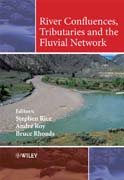
River Confluences, Tributaries and the Fluvial Network brings together state-of-the-art thinking on confluence dynamics tributary impacts and the links between processes at these scales and river network functions. Taking a global approach, this multiauthored text features a team of carefully selected, internationally renowned experts who have all contributed significantly to recent groundbreaking advances in the field. The book is unique in focus, content, scopeand in bringing together engineering, ecological and geomorphological approaches to the three key areas of river system science. INDICE: List of contributors. Preface. 1. Introduction: river confluences,tributaries and the fluvial network (Stephen P. Rice, Bruce L. Rhoads and André G. Roy). Introduction. Key aims of the book. Sections of the book. References. PART I: RIVER CHANNEL CONFLUENCES. 2. Introduction to Part I: river channel confluences (André G. Roy). Introduction. Individual chapters. Reference. 3.Modelling hydraulics and sediment transport at river confluences (Pascale M. Biron and Stuart N. Lane). Introduction. Hydraulics. Bedload, suspended and solute transport. Conclusion. Acknowledgements. References. 4. Sediment transport, bed morphology and the sedimentology of river channel confluences (James L.Best and Bruce L. Rhoads). Context. Bed morphology. Sediment transport. Sedimentology. Conclusions. Acknowledgements. References. 5. Large river channel confluences (Daniel R. Parsons, James L. Best, Stuart N. Lane, Ray A. Kostachuk,Richard J. Hardy, Oscar Orfeo, Mario L. Amsler and Ricardo N. Szupiany). Introduction. Bed morphology. Flow structure at large river channel confluences. Flow mixing at large river confluences. Conclusions. Acknowledgements. References. 6. Management of confluences (Robert Ettema). Introduction. Unruly confluences. Management approaches. Managing confluences for sediment transport. Managing confluences for ice passage. Summary. References. 7. Unconfined confluences in braided rivers (Peter Ashmore and J. Tobi Gardner). Introduction. General characteristics and significance of confluences in braided channels. Confluence scour depth. Confluence kinetics and bar formation. Confluence spacing andthe length-scale of braided morphology. Sediment transport and sediment budgets. Sediment sorting and alluvial deposits. Prospect. Acknowledgements. References. PART II: TRIBUTARY-MAIN-STEM INTERACTIONS. 8. Introduction to Part II: tributary-main-stem interactions (Stephen P. Rice). Introduction. Individual chapters. References. 9. Spatial identification of tributary impacts in river networks (Christian E. Torgersen, Robert E. Gresswell, Douglas S. Bateman and Kelly M. Burnett). Introduction. Data measurement. Intensive sampling. Extensivedesigns. Field measurement. Remote sensing. Analytical tools. Future developments and challenges. Acknowledgements. References. 10. Effects of tributaries on main-channel geomorphology (Robert Ferguson and Trevor Hoey). Introduction.Conceptual considerations. Empirical evidence. Theoretical models: (1) Regimeanalysis of confluences. Theoretical models: (2) Numerical experiments with adjustable grain-size distributions. Discussion. Acknowledgements. References. 11. The ecological importance of tributaries and confluences (Stephen P. Rice,Peter Kiffney, Correigh Greene and George R. Pess). Introduction. Tributaries, confluences and river ecology. Tributaries, ecosystem functions and river management. Constraints on understanding and progress. Tributary nutrient loading, basal stream productivity and higher-order aquatic and terrestrial fauna: acase study. Discussion. Conclusion. Acknowledgements. References. 12. Tributaries and the management of main-stem geomorphology (. Frédéric Liébault, HervéPiegay, Philippe Frey and Norbert Landon). Introduction. A conceptual framework for assessing the geomorphological impact of tributaries and their importance for main-stem management. Managing the geomorphological impact of tributaries: the case of the Drôme River, SE France. Conclusion. Acknowledgements. References. 13. Confluence environments at the scale of river networks (Lee Benda). Introduction. River network structure and confluence environments. Symmetry ratios and confluence environments. Basin shape, network patterns and confluence environments. Local network geometry. Drainage and confluence density. River network scaling properties of confluence environments. Stochastic watershed processes: river network organization of erosion and sediment-supply dynamics.The role of hierarchical branching networks on the frequency and magnitude ofsediment supply, transport and storage. Discussion. River networks, resource management and river restoration. Acknowledgements. References. PART III: CHANNEL NETWORKS. 14. Introduction to Part III: channel networks (Bruce L. Rhoads). Introduction. Individual chapters. References. 15. Hydrologic dispersion in fluvial networks (Patricia M. Saco and Praveen Kumar). Hydrologic dispersion effects on runoff response. Runoff response as travel-time distributions: the GIUH. Geomorphological dispersion in stream networks. Non-linear effects and the use of hydraulic geometry relations. Kinematic dispersion in stream networks. The effect of scale and rainfall intensity on the dispersive mechanisms. Hillslope dispersive effects. Kinematic dispersion effects using the meta-channelapproach. Summary and future research directions. Acknowledgements. References. 16. Sediment delivery: new approaches to modelling an old problem (Hua Lu and Keith Richards). Introduction. The concept of sediment delivery. Difficulties in measuring and estimating sediment yield and SDR. Links between hydrologyand sediment production and yield. Physical inferences of sediment delivery based on a simple lumped model. Practical large-scale application using a distributed model. Conclusions. Acknowledgements. References. 17. Numerical predictions of the sensitivity of grain size and channel slope to an increase in precipitation (Nicole M. Gasparini, Rafael L. Bras and Gregory E. Tucker). Introduction. Landscape-evolution models. Example simulation of network evolution. Discussion. Conclusions. Acknowledgements. References. 18. Solute transport along stream and river networks (Michael N. Gooseff, Kenneth E. Bencala and Steve M. Wondzell). Introduction. Linking transport processes with the fluvial geomorphic template. Forward-looking perspective. Acknowledgements. References. 19.Fluvial valley networks on Mars (Rossman P. Irwin III, Alan D. Howard and Robert A. Craddock). Introduction. Early observations. Distribution, age, origin and morphology of valley networks. Morphometry. Alluvial deposits. Hydrology. Summary. Acknowledgements. References. Index.
- ISBN: 978-0-470-02672-4
- Editorial: John Wiley & Sons
- Encuadernacion: Cartoné
- Páginas: 416
- Fecha Publicación: 18/07/2008
- Nº Volúmenes: 1
- Idioma: Inglés
